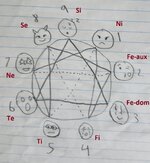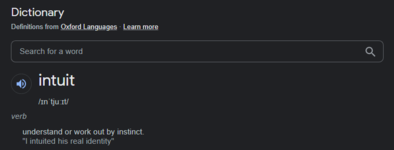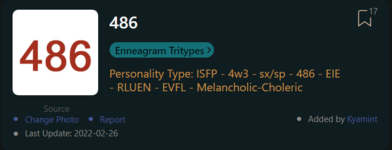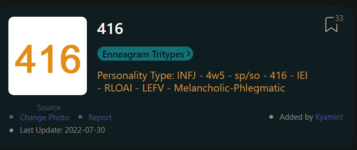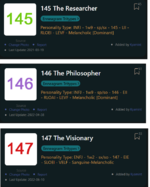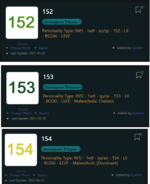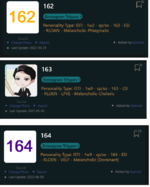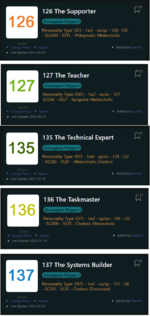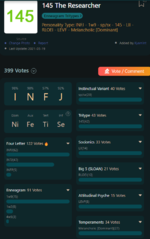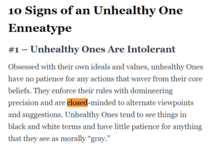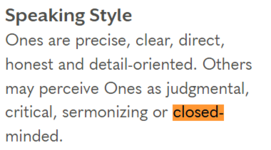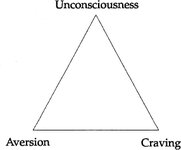Hi
@Indigo Rodent , welcome to the debate!
Superego thing sounds suspiciously like Feeling function.
I don't type by Cognitive Functions anymore, but no prob following your reasoning.
One could argue that some stereotypical STJ E1 traits come from their stunted Fi not from Enneatype itself. From my point of view as INFP things are much less codified since I always have my Fi available most of time.
But then, just because the code isn't written down, isn't spoken, it doesn't mean it isn't here and isn't followed somewhat rigidly. Lol, I can even write it down. Lots of thou shalts and thou shalt nots.
Using CF-speak, yes, I agree: Te-Fi axis with Te over Fi, hence either Te-dom or Te-aux, aka ETJ or ITJ. But notice that ENTJ is pretty much incompatible with E1, and as I said, I don't see a "true" INTJ either (i.e. strong N) either. E1 is close-minded and detail-oriented in Naranjo's view. It seems to imply that the core point is not just Te per se, also Si.
So, apart from J, the second strongest lean of the E1 archetype would be S, not T. In CF-speak, SJ means Si, as it is commonly described.
These are SJs for Keirsey in a nutshell:
The SJs
Myers had SJs, like SPs, observing their close surroundings with a keen eye, but for an entirely different reason, namely that of scheduling their own and others' activities so that needs are met and conduct is kept within bounds. Thus for SJs, everything should be in its proper place, everybody should be doing what they're supposed to, everybody should be getting their just deserts, every action should be closely supervised, all products thoroughly inspected, all legitimate needs promptly met, all approved ventures carefully insured. Though SJs might differ in being tough-minded or friendly in observing their schedules, and though they can be expressive or reserved in social attitude, all of them demand that ways and means of getting things done are proper and acceptable.
And so Myers described the SJs as "conservative" and "stable" — as "consistent" and "routinized" — as "sensible," "factual," and "unimpulsive" — as "patient," "dependable," and "hard-working" — as "detailed," "painstaking," "persevering," and "thorough." This too is a clear-cut pattern of action and attitude, highly unlike that of the SPs, NFs, and NTs.
I'm not saying that all E1 are SJ nor that all SJs are E1, but it's a very nice fit.
I'm also aware that SJs can be typically E6 too, but that's because there's an overlap between E1 and E6.
This is Naranjo:
REMARKS FOR THE DIFFERENTIAL DIAGNOSIS AMONG SOME PERSONALITY TYPES
I/VI:
The predominantly dutiful variety of E VI may be difficult to discriminate from E I; one difference lies in the greater assertiveness of the latter; another, the greater difficulty of the fearful in coming to decisions. Also, E I is more active.
So, again: E1 is more assertive, is less anxious when coming to decision, and is more active. Two breeds of SJ: one is more "heady", so more based in reasoning, planning for the worst case, theoretical, skeptical (E6), the other more resolute, confident in being right, rigid and close-minded (E1). Both SJ as described by Keirsey: stable, routinised, factual, unimpulsive, hard-working, persevering, etc.
Also, I think enneatype is an overlay on MBTI type, so to me it's more about differences within type, than something that is sourced in type.
I respectfully disagree. You seem to imply that MBTI is your core, with E-type as a flavour on top of it. I believe they are just two ways of seeing the same thing, and in most of the cases, they actually depict the same concrete person. Some combos are so much the same that they describe the same, for example INTP E5 or ESFP E7, but many, many others.
One implication is that, although there's some latitude in E-type / MBTI combination, some are very, very unlikely.
The combo you state in your profile seems to be one of those IMHO,
@Indigo Rodent , and I say so with all due respect and without the intention to overstep. I don't know you, and of course you know yourself more than anybody, but I can suspect that all the noise and the misinformation that you have around on the web can easily lead to see yourself into some labels that are misinterpreted.
To clarify, I don't doubt how you see yourself, I doubt how Typology has been passed to you.
Because Fi-dom and E1 are pretty much incompatible.
Not to repeat myself, but Naranjo describes E1 as rigid, dominant, assertive, oriented to action, detail-oriented, not open-minded, lacking spontaneity... I have strong problems seeing it in an IFP, even less in an INFP, one of the least practical of the types. However, it could very easily be INFP 9w1.
I'll give you 2 examples of the two archetypes to see which you resonate the most with: my wife, INFP E9w1 and her older sister, ESTJ E1w9. (see why I bring it forth? Very relevant to your case, and to the OP in general). I'll call them Kate and Nancy.
Kate is a INFP 9w1, a clear introvert, nice and friendly, modest, quiet, good listener, a bit timid although in her forties. She's unassuming, has many friends because she can mesh and accomodate most people; she's fine with most things and usually goes along; she likes confort and leading a simple life. She has strong artistic interesest, studied Fine Arts, paints and teaches in High School. Non-materialistic, very intuitive with people, Highly Sensitive. She doesn't have strong preferences, but has deeply held values and, when somebody trespasses one of those, she stubbornly becomes either passive-aggressive or even self-righteous.
She's very IP: lazy, procrastinating, low-energy, even passive; however, her heart (loving kindness) compels her to act. And she's quite intelligent, she knows that not doing her duty is very selfish, hence she's very dutiful and quite hard working, although she reverts to her easygoing lay-in-the-couch-reading-or-binging-netlifx ASAP - which is actually quite seldom actually because she's taken a lot of responsibilities in life as a mother and wife and daughter of an old mother and teacher. So you can see the 1 wing on top of the 9 core.
Nancy is an ESTJ E1w9 steamroller: high energy, sociable, talkative, very resolute, quite know-it-all, hard working when younger (she's in her fifties right now). She knows the right way to do anything and she'll happily tell you what you're doing wrong and what you should be doing instead. Quite difficult in relationships, can be harsh and unempathetic to get the job done. Represses her true feelings. Very conservative, close-minded, no artistic interest whatsoever: her ideal of beauty is neatness and order. Has a workaholic husband, no children, used to be a workaholic top executive herself in banking until she had a nervous breakdown. Now she leads a secluded life and rarely goes out of her mansion in the countryside. Is rich but can't really enjoy it, apart from gourmet food and some luxury items for the house. So you can see the 9 wing on top of the 1 core.
Notice that both are in the Gut triad: it's their "gut knowing" that leads the way. They're not particularly introspective, neither of them. Don't care too much about what others think of them (E9 Kate even less), their just do what "feels right", nor have the ability/interest to coldly analyse dispassionately, entertaining ideas in an open-minded fashion, intellectually (E1 Nancy even less).
(In CF-speak, no Fe nor Ti in sight in both)
Now, the tricky part: which one has strongest "principles" and "values"?
Well, E1 Nancy is quicker to act, good at fixing problems because she has strong principles to lead her action, but her principles are formulaic, she's not in touch with her feelings or her heart nor those of other people, so she can believe she's right but actually get it very wrong and discover it way down the road. But can be very effective.
E9 Kate is slower to act but checks with her heart for everything she does; she has a strong gut reaction against stuff she feels it's wrong and intuitively knows when something is "bad". But can procrastinate and stay "stuck" and not act for a long time.
E1 Nancy could stay in a job that wasn't right for her for 5+ year because "it's my duty", got rich but destroyed herself emotionally. E9 Kate had a problem finding her niche in the job market, but when she started a job that she felt "it's not right for me" for moral reasons (too money-oriented, not respectful of pupil's interests in the way they taught) she knew it the first day and could just keep it for 3 months and then quit. Less material stability but more peace of mind.
As you can see, you can't really compare their values: they are a different beast, coming from a different place, about different approaches to life.
Which one do you resonate the most?

